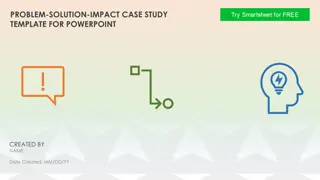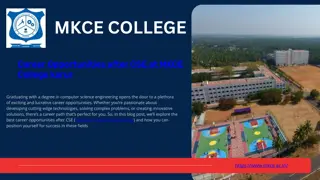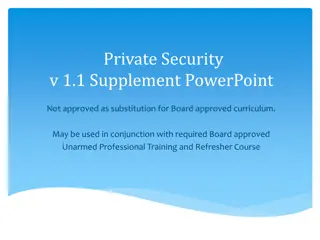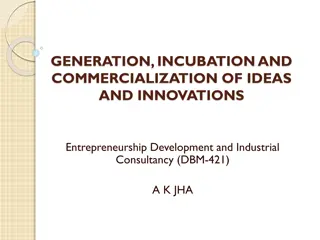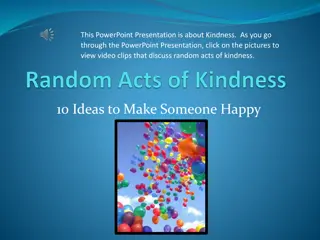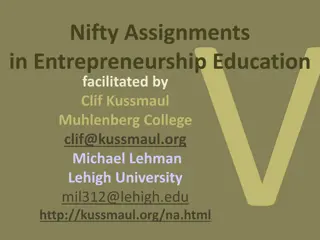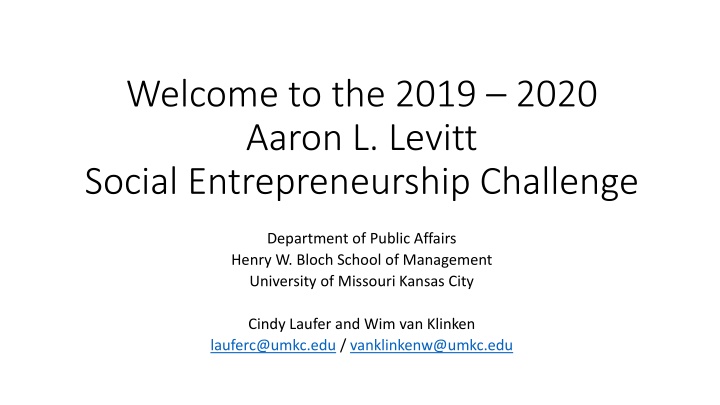
Innovative Solutions for Social Impact Challenges
Explore the Aaron L. Levitt Social Entrepreneurship Challenge at the University of Missouri-Kansas City, focusing on the principles of social entrepreneurship, innovative problem-solving, and management strategies across various organizational models. Dive into understanding social issues, developing viable plans, and unleashing your passion to create sustainable solutions with lasting impact.
Download Presentation

Please find below an Image/Link to download the presentation.
The content on the website is provided AS IS for your information and personal use only. It may not be sold, licensed, or shared on other websites without obtaining consent from the author. If you encounter any issues during the download, it is possible that the publisher has removed the file from their server.
You are allowed to download the files provided on this website for personal or commercial use, subject to the condition that they are used lawfully. All files are the property of their respective owners.
The content on the website is provided AS IS for your information and personal use only. It may not be sold, licensed, or shared on other websites without obtaining consent from the author.
E N D
Presentation Transcript
Welcome to the 2019 2020 Aaron L. Levitt Social Entrepreneurship Challenge Department of Public Affairs Henry W. Bloch School of Management University of Missouri Kansas City Cindy Laufer and Wim van Klinken lauferc@umkc.edu / vanklinkenw@umkc.edu
Understandings of Social Entrepreneurship (Alvord, Brown, & Letts, 2002) Combining commercial enterprises with social impacts. (Create an enterprise to accomplish social purposes.) Innovating for social impact. (Provide band-aids using the funds of those who are passionate about the issue) A way to catalyze sustainable social transformation. (Not primary focused on the band-aid but on addressing the deep societal causes of the issue)
Innovative solutions Innovative solutions to social problems are more effective, create deeper change, and are more long-lasting, when they take into account: a clear understanding of the people experiencing the issues, the community, the social ecosystems, and the policy environment that are often at the heart of these issues. Attention must be paid to potential partners, competitors, and the forces that encourage or discourage entry into the system. Barreiro & Stone, 2013
Management Across the Continuum: From Purely Philanthropic to Purely Commercial Traditional Nonprofit Nonprofit with Income- Generating Activities Social Enterprise Socially Responsible Business Corporation Practicing Social Responsibility Traditional For-Profit Mission Motive Stakeholders Accountability Income Reinvested in Social Programs or Operational Costs Profit-Making Motive Shareholder Accountability Profit Redistributed to Shareholders
The Levitt Challenge Purpose Your passion for an issue A viable plan
Your passion What is it?
Your issue Can you describe it concisely? Why is it a problem? Get to the root cause(s) Who is impacted and how?
Your ideas Which (core) issue(s) do you think you can address? What are some ideas that can be implemented to address the issue?
Finding opportunities The entrepreneur always searches for change, responds to it, and exploits it as an opportunity. Opportunities in the social and public sectors are changes in the environment that allow for the entrance of a new idea or approach. Determining the most likely sources of opportunities is a critical third area for attention for a social entrepreneur. Opportunities happen all the time. So monitoring sources for opportunity is part of the ongoing work of a social entrepreneur. Barreiro and Stone (2013)
Opportunity Exploration What are the changes in the environment/eco- system you see that might mean an opportunity? What are opportunities you think might be candidates to pursue? What are the unknowns? What will you do to become better informed?
Next Workshop ~ January 18 Continue to work on refining and describing concisely your specific issue(s), idea(s), and opportunities Read Chapter Three Understanding Those to Be Served and Their Communities



